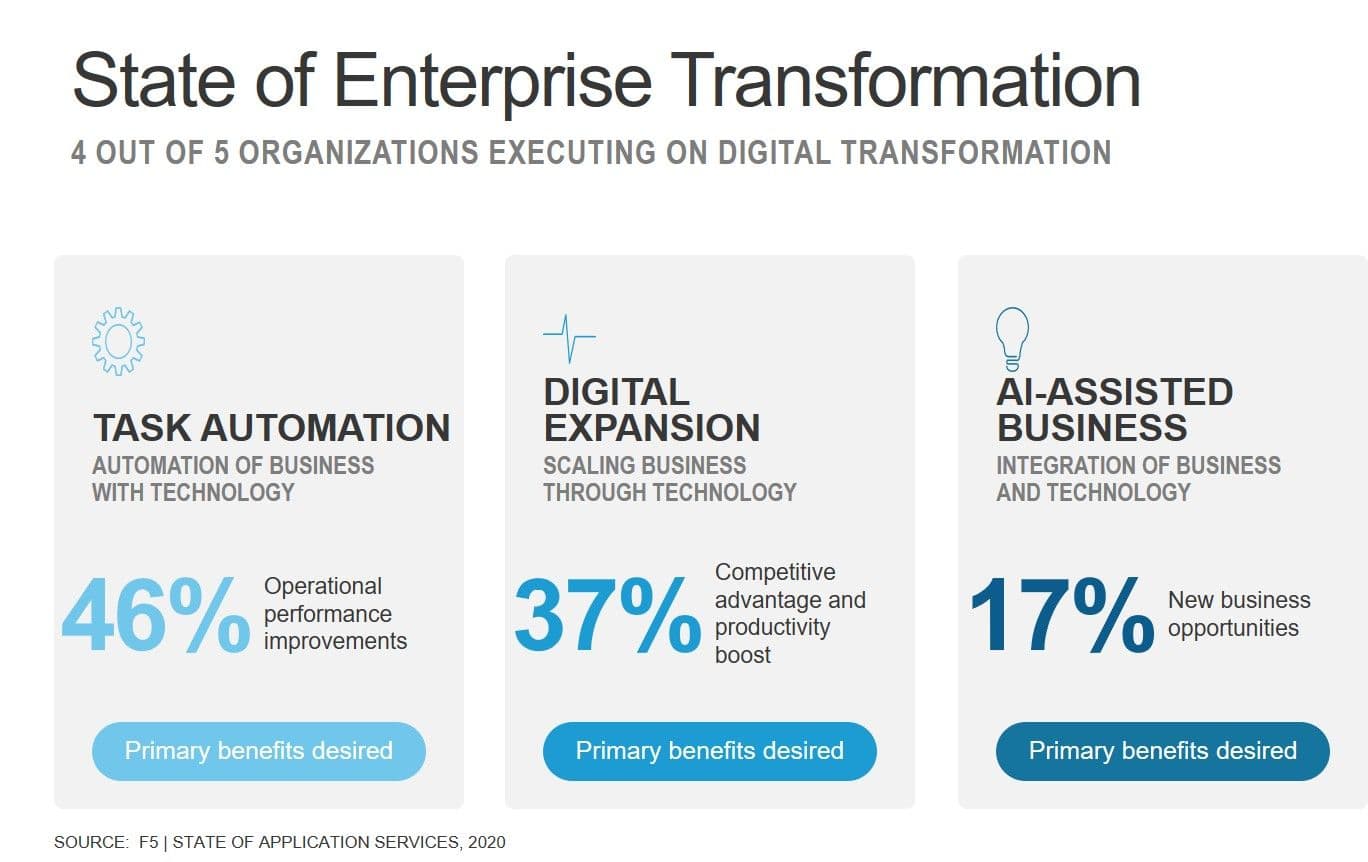Back in 2018, we talked about a lot of changes happening in "the network" due to changes in application architectures and digital transformation. The inability to scale mostly manual-processes to keep up with growing demand was—and continues to be—a key driver for automation across IT. These mostly manual processes also exist outside IT. Indeed, most businesses have traditionally operated with largely manual processes augmented by applications.
That is changing as demand continues to exert pressure on business to offer digital equivalents to everything from IT to customer service. For many, that change is accelerating due to circumstances wrought by COVID and the resulting shift in consumer preferences toward digital interfaces.
Digital Transformation: Phase 1
The first phase of digital transformation was dominated by automation. Most of that automation was focused on a single task. This is true whether we view automation through the lens of NetOps or the business. In the network, automation was focused on tasks like:
- Configure a new VLAN on a switch
- Launch a new virtual machine
- Add a new rule to the firewall
On the business side, there were similar, task-oriented automation efforts happening:
- Create an account
- Submit an order
- Process a payment
These are helpful, and certainly necessary, steps to forward progress on the digital transformation journey. But that journey doesn't end once we've automated a single task. There's more to do than automate individual steps in what is a much larger process.
Digital Transformation: Phase 2
It's the automation of process—orchestration—that is the focus of the second phase of digital transformation. It's recognizing that configuring a new VLAN, launching a new virtual machine, and adding a new rule to the firewall are all part of a workflow that, when automated, becomes a digital workflow. If you look at a mature CI/CD pipeline operated by a well-oiled DevOps machine, you'll note that "continuous" is not just a descriptive term, it's a reality. The pipeline is a fully integrated process that executes individually automated tasks and produces a "ready to deliver to production" application. It is an early, successful example of a digital workflow.
On the business side, we see increasing automation of processes that approximate a digital workflow. That might be creating an account, submitting an order, and processing a payment as part of a larger workflow that, when automated, becomes a digital workflow. When we talk about this from a customer-facing perspective, we call it a customer (or digital) experience, but it's the same underlying concept.

All functions within business—from marketing to IT, from finance to customer service—are engaged in this process as organizations recognize the advantages of automating processes, i.e. creating digital workflows. An IDC automation survey found that 69% of respondents are already using—or looking to use—workflow automation software. Digital workflows are automating IT ticketing processes, enhancing self-service, guided troubleshooting for customer products, and streamlining internal processes that govern everyday business concerns. These workflows involve multiple applications, often crossing corporate and cloud boundaries alike. Operating, monitoring, and securing these workflows will require new capabilities and a great deal of data.
The transformation from discrete, disconnected tasks to a holistic digital workflow doesn't happen overnight. An entire category of solutions is cropping up and providing services that accelerate the integrations required, but it takes time to implement.

From our research, we see the enterprises today in all three phases of digital transformation. While most are focused on phase one automation, more than a third are already expanding their digital capabilities in phase two. We expect to see a steady shift as organizations accelerate transformation efforts.
The focus on digitizing of workflows in phase two will ultimately offer business a path forward to the third phase of digital transformation, where data-driven services will generate actionable insights that improve efficiency, reduce process friction, and increase both productivity and profits.
About the Author

Related Blog Posts

Multicloud chaos ends at the Equinix Edge with F5 Distributed Cloud CE
Simplify multicloud security with Equinix and F5 Distributed Cloud CE. Centralize your perimeter, reduce costs, and enhance performance with edge-driven WAAP.
At the Intersection of Operational Data and Generative AI
Help your organization understand the impact of generative AI (GenAI) on its operational data practices, and learn how to better align GenAI technology adoption timelines with existing budgets, practices, and cultures.
Using AI for IT Automation Security
Learn how artificial intelligence and machine learning aid in mitigating cybersecurity threats to your IT automation processes.
Most Exciting Tech Trend in 2022: IT/OT Convergence
The line between operation and digital systems continues to blur as homes and businesses increase their reliance on connected devices, accelerating the convergence of IT and OT. While this trend of integration brings excitement, it also presents its own challenges and concerns to be considered.
Adaptive Applications are Data-Driven
There's a big difference between knowing something's wrong and knowing what to do about it. Only after monitoring the right elements can we discern the health of a user experience, deriving from the analysis of those measurements the relationships and patterns that can be inferred. Ultimately, the automation that will give rise to truly adaptive applications is based on measurements and our understanding of them.
Inserting App Services into Shifting App Architectures
Application architectures have evolved several times since the early days of computing, and it is no longer optimal to rely solely on a single, known data path to insert application services. Furthermore, because many of the emerging data paths are not as suitable for a proxy-based platform, we must look to the other potential points of insertion possible to scale and secure modern applications.
